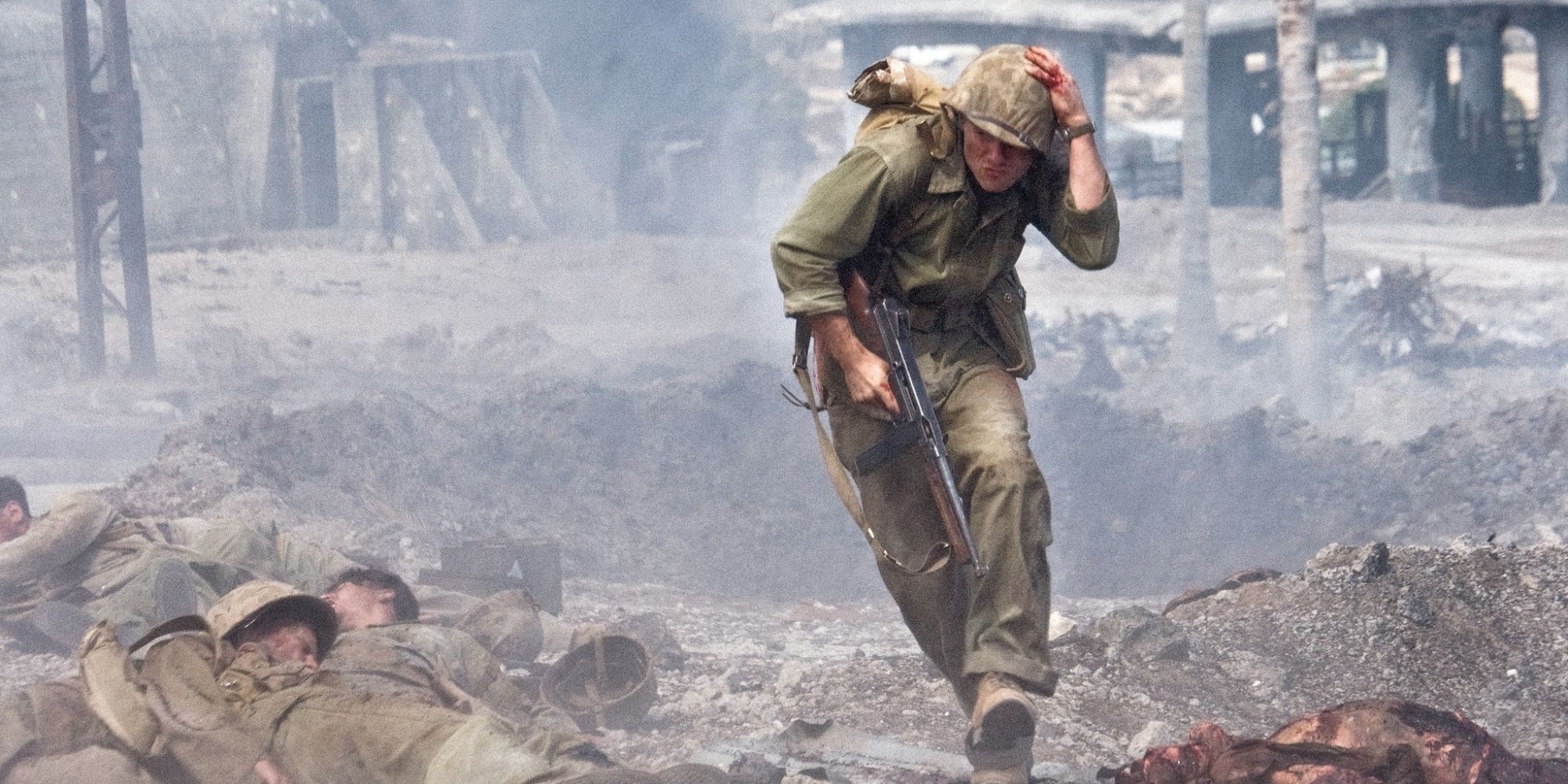World War II historian John McManus dives into The Pacific‘s depictions of combat in the Pacific Theater, explaining why they rate highly among on-screen portrayals of the conflict. Produced by Steven Spielberg, Tom Hanks, and Gary Goetzman, the HBO miniseries depicted the journeys of three United States marines by drawing on the memoirs of Eugene Sledge, Robert Leckie, and Chuck Tatum. Unflinching and honest in its portrayal of the conflict, The Pacific has earned widespread critical acclaim.
Over fourteen years after it first aired, The Pacific has been revised by McManus, a professor of military history, and Insider in a new expert reaction video.
Focusing on the fifth and sixth episodes of the miniseries, the historian quickly praised both its depictions of the equipment utilized by the Marine Corps, as well as the context behind some of the series’ battles. He said:
What are called the LVTs – Landing Vehicle Tracked, which they really did use – they come out of these larger landing craft[s] called LSTs – Landing Ship Tank. And you see they go down that ramp, and then they splash into the water, and the water comes up all over you as the crew. Dead-on right.
So what happens at Peleliu, there’s a colonel there on the Japanese side named Nakagawa, who is the main commander, and he has this concept of a layered defense. He’s going to resist to some extent at the waterline, but he’s got all kinds of caves and excellent, really well-concealed, prepared-by-nature-type fighting positions for himself on Peleliu. So yes, his main objective is he’s going to bleed the Americans once they get ashore, but he also has enough combat power to resist at the waterline as well. When there’s that much firepower going around, anybody standing up is really vulnerable, so people tend to go to ground.
McManus would later dive into how appropriate the choice of weaponry was for the feature, culminating in him giving the feature a rating of nine out of ten for how it depicted the Pacific Theater.
That’s a 60mm mortar, and you can see the mortar sight, how important that is, how they would’ve carried that in a special box and then set it up, and then you could see the shells as they put down the tube there. The mortar explosions, not a lot of flames, nothing like that. It’s exactly the kind of thing you would’ve had. Those grenade launchers were used a lot, especially in this kind of circumstance where you’ve got this sort of observable target that you can’t always get straight-line fire on it.
Got an M1 Garand rifle, you would take the clip out of the live ammo clip, you’d put a special dummy bullet in there, you would fix the sort of grenade at the end of your rifle that then would provide the charge for this grenade. Of course, you better remember to take the live rounds out of there, because if you don’t, you’re going to have a heck of an explosion right in front of you.
I would rate these a 9 out of 10. I mean, it’s really pretty amazing filmmaking.
What This Means About The Pacific & Its Legacy
Great Care Was Taken For A True To Life Portrayal
For those familiar with The Pacific‘s production, it is unsurprising why it rates highly among depictions of World War II. Developed as a companion piece to the producers’ 2001 European Theater-focused Band of Brothers, great care was taken in laying out the story the creative team hoped to depict onscreen. As such, The Pacific brought on Hugh Ambrose, son of historian and prior Spielberg and Hanks collaborator Stephen Ambrose, to consult, while returning writer Bruce C. McKenna led work on the script.
Furthermore, both The Pacific and Band of Brothers were followed by a documentary titled He Has Seen War in 2011, which dove into the aftermath of the war and its impact on many of the souls who served in Europe and the Pacific, including recollections from Sledge and Leckie’s family members. While all the shows in this spiritual trilogy, which also included the recent Masters of the Air, featured dramatized elements, it is clear that those involved still valued realism and aimed to depict war as truthfully as they could, which only made each title more memorable.
Our Take On The Pacific’s Positive Historian Grade
Spielberg Has Experience In Exploring The Conflict
Spielberg has had involvement in several projects exploring World War II in addition to Band of Brothers and The Pacific, from the farcical and fantastical depictions in 1941 and the Indiana Jones series, to the carefully constructed, respectful drama of Schindler’s List and Saving Private Ryan. The latter two movies have long received great acclaim for their portrayal of the infamous conflict.
For
Schindler’s List,
Spielberg received the Order of Merit of the Federal Republic of Germany, and for
Saving Private Ryan,
he received the Medal for Distinguished Public Service.
Considering Spielberg’s previous work, it is unsurprising that The Pacific has received similar praise for its accuracy. The director clearly has a lot of respect for historical facts and in paying homage to the real life heroic acts that took place during World War II. This has only ensured the show stands the test of time. As such, upon hearing McManus’ approval, many may be keen to give The Pacific another viewing to get a good grasp on the ferocity and chaos the Pacific Theater featured.
Source: Insider
Checkout latest world news below links :
World News || Latest News || U.S. News
The post How Steven Spielberg’s The Pacific Battles Are “Dead On Right” Explained By Historian appeared first on WorldNewsEra.

